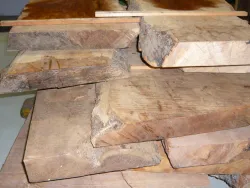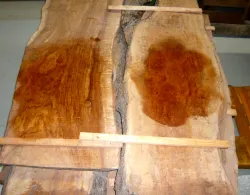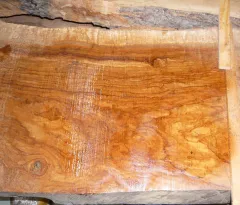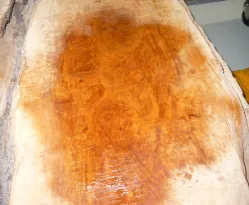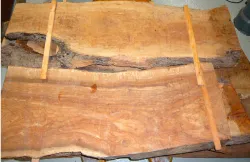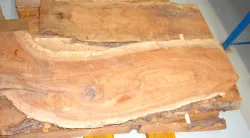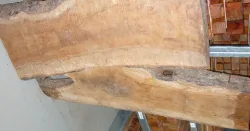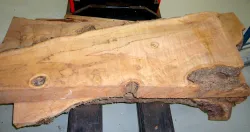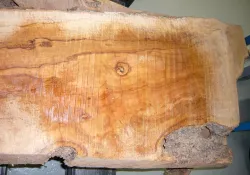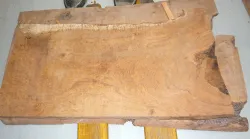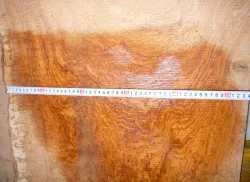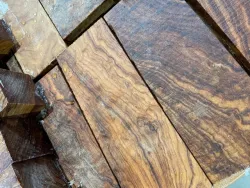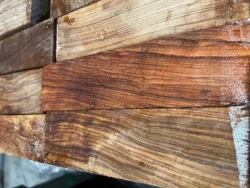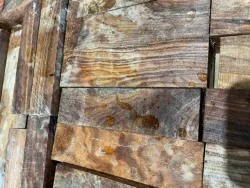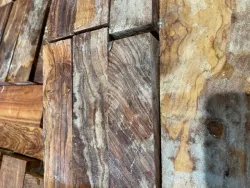Shipping country
Wood Species
Olive wood- always fascinating
30.08.2021
One of the important qualities and virtues of a timber merchant is to have a lot of patience when dealing with timber. That's why we usually store the wood we sell to our customers for several years until it is really dry enough to be processed immediately.
Sometimes we are particularly pleased when we find treasures in the warehouse that have been put away for a long time and had to go through a lengthy drying process. This is exactly what happened to us with a batch of thick olive wood planks. These had certainly been stored for a couple of years since their visit to the sawmill, yet they were far too damp to sell with a clear conscience.
These olive wood planks are certainly some of the nicest we've had cut to size in a long time. Very large widths, respectable lengths and then thick planks with 50-60 mm thickness: it is a real pleasure to rediscover this treasure after a few years of drying.
By the way, this olive wood is not comparable to other wood from normal Spanish or Italian olive trees: it comes from a very special small-fruited olive species that grows almost exclusively on Corfu: the tree belongs to the Linaoleia family, a variety that grows unusually tall, often reaching heights of up to 20 meters. These trees have a long history dating back to the 16th century. Brought by the Venetians, these trees of the Lianoleia variety grow strongly in height and form strong trunks with rich foliage. Their wide distribution was the result of measures taken by the Venetian government, which rewarded the planting of young olive trees with high premiums. This led to an impressive increase in the number of olive groves on the island. The oils obtained were mostly burned in oil lamps, the tiny olives of this variety with their high yield were the first choice for this purpose, and since you can wait for them to fall voluntarily from the trees in autumn, you can still find dense forests of the trees as tall as houses on Corfu.
It is believed that all the cities on the Adriatic Sea occupied by the Venetians were illuminated with the illuminating oil produced on Corfu and exported from there. Certainly, the expansion of olive groves was at the expense of the cultivation of wine, cereals and vegetables, so that the Corfiotes were forced to import these species from the opposite mainland.
Sometimes we are particularly pleased when we find treasures in the warehouse that have been put away for a long time and had to go through a lengthy drying process. This is exactly what happened to us with a batch of thick olive wood planks. These had certainly been stored for a couple of years since their visit to the sawmill, yet they were far too damp to sell with a clear conscience.
These olive wood planks are certainly some of the nicest we've had cut to size in a long time. Very large widths, respectable lengths and then thick planks with 50-60 mm thickness: it is a real pleasure to rediscover this treasure after a few years of drying.
By the way, this olive wood is not comparable to other wood from normal Spanish or Italian olive trees: it comes from a very special small-fruited olive species that grows almost exclusively on Corfu: the tree belongs to the Linaoleia family, a variety that grows unusually tall, often reaching heights of up to 20 meters. These trees have a long history dating back to the 16th century. Brought by the Venetians, these trees of the Lianoleia variety grow strongly in height and form strong trunks with rich foliage. Their wide distribution was the result of measures taken by the Venetian government, which rewarded the planting of young olive trees with high premiums. This led to an impressive increase in the number of olive groves on the island. The oils obtained were mostly burned in oil lamps, the tiny olives of this variety with their high yield were the first choice for this purpose, and since you can wait for them to fall voluntarily from the trees in autumn, you can still find dense forests of the trees as tall as houses on Corfu.
It is believed that all the cities on the Adriatic Sea occupied by the Venetians were illuminated with the illuminating oil produced on Corfu and exported from there. Certainly, the expansion of olive groves was at the expense of the cultivation of wine, cereals and vegetables, so that the Corfiotes were forced to import these species from the opposite mainland.



